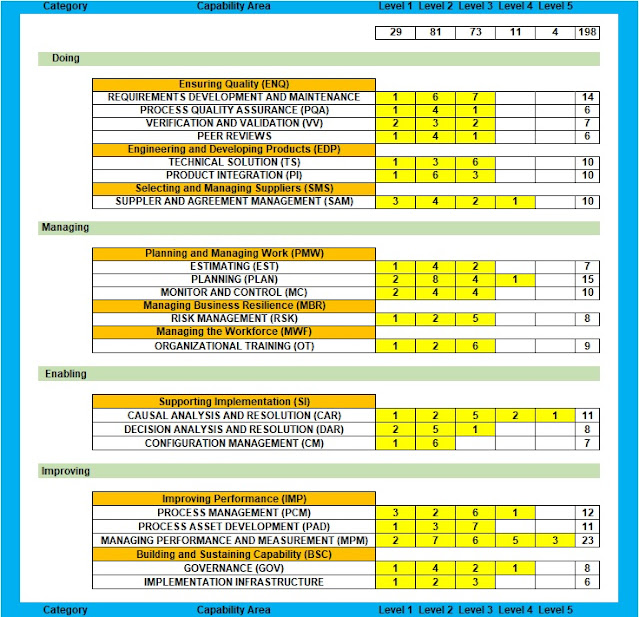CMMI V2.0 was released on March 28, 2018. V2.0 is the next release of V1.3 and would replace it completely after the sunset period gets over on March 31, 2020.
At the first glance, and on a cursory walkthrough of CMMI V2.0, here are some interesting observations on V2.0:
- The structure of the framework has changed.
- At the first layer, there are "Categories". There are 4 categories - Doing, Managing, Enabling and Improving.
- At the second layer, there are "Capability Areas". There are 9 capability areas spread across the four "Categories".
- At the third layer, there are "Practice Areas". There are 20 practice areas in all in CMMI V2.0.
- At the fourth layer, there are "Capability Levels". There are 5 capability levels. Not every practice has all the five capability levels.
- In fact, there are just two practice areas that have all the 5 capability levels - CAUSAL ANALYSIS AND RESOLUTION (CAR) and MANAGING PERFORMANCE AND MEASUREMENT (MPM).
- And there are four practice areas that have 4 capability levels - SUPPLER AND AGREEMENT MANAGEMENT (SAM), PLANNING (PLAN), PROCESS MANAGEMENT (PCM) and GOVERNANCE (GOV)
- There is just one practice area that has only 2 capability levels - CONFIGURATION MANAGEMENT (CM).
- Remaining (thirteen) practice areas have 3 capability levels.
- At the fifth and the final layer, there are "Practises", These practises, effectively speaking, constitute the CMMI V2.0 requirements. There are 198 practises in all spread across the 20 practice areas.
- Estimation has become a full-fledged and separate practice area. It used be a part of "Project Planning" process area in CMMI V1.3.
- Not only that, the work flow for estimation is clearly laid down in the model - Scope the work, Estimate the size, Estimate the effort using size, Estimate the time/schedule, Estimate the cost and record the rationale/assumptions throughout the above work flow.
- There is no longer any ambiguity in V2.0 around the need for sizing unlike in V1.3 where it was implied by the specific practice "Establish and maintain estimates of work product and task"
- In measurement related practises in V2.0, there is now an explicit practice related to "Data Quality". This was always important and was implicitly included in V1.3 as a note but with Data Management Maturity (DMM) coming into picture, this has acquired increased significance.
- The practises at level 4 (in whichever practice areas they appear) seem to focus on using data/metrics to manage the related activity. In a similar manner, the practises at level 5 (in whichever practice areas they appear) seem to focus on using data/metrics to improve the related activity.
- The twist in the tale is that though level 5 appears in only two practice areas - CAUSAL ANALYSIS AND RESOLUTION (CAR) and MANAGING PERFORMANCE AND MEASUREMENT (MPM) - however, both of these are so generic that they apply to every other practice area and virtually every activity that happens in any project!
- The above has a fundamental, deep and direct connect with how an organization can achieve sustained success? There is essentially a very simple two-step approach:
- What is step 1? Plan things very well. And how can this be taken care of? Follow practises similar to what would be expected in an area like MANAGING PERFORMANCE AND MEASUREMENT (MPM) .
- What is step 2? In case things don't go as per plan, analyze and address the underlying reasons in a permanent manner, so that those reasons are forever addressed. And how can this be taken care of? Follow practises similar to what would be expected in an area like CAUSAL ANALYSIS AND RESOLUTION (CAR).
- A schematic structure of CMMI V2.0 is given below. It shows the "Categories", "Capability Areas", "Practice Areas", "Capability Levels" and number of "Practises" at each capability level that appears for a specific practice area.

No comments:
Post a Comment